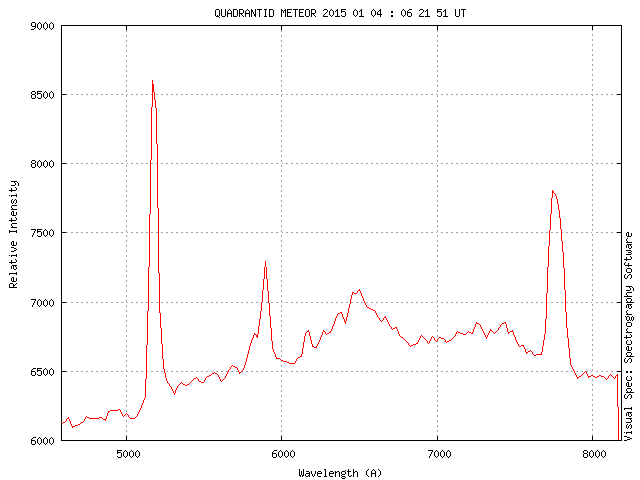› Forums › Meteors › Quadrantids 2015 › Hi,
Hi,
Thanks Alex, That’s the plan. I have one on bearing 130 at ~45 deg as weather permits.
Back to the Quadrantids, I did record several others, all fainter and one through considerable cloud. When processing them I noticed something of (possible) significance.
Consider:




These are the synthetic spectra of 4 Quadrantids.
Q1 is of the first post. Q2, Q3 and Q4 were the fainter ones.
Note: I have made no attepmt to align the lines in this case. They were all captured with the same 300 groove/mm grating. Due to varying angles with respect to the dispersion axis it looks like they have different dispersions (the lines at varying distances from one another) this is a geometric effect caused by the re-orientation process. The physical dispersion is the same in all.
Now, it is apparent that Q2, Q3 and Q4 have the green Magnesium (~518nm) line brighter than the yellow Sodium (~590nm) line. With Q1 it is a bit difficult to tell. This is where the graphs now have to come into play.
So,




The graphs are in the same order. It is clear that Q1 is the only one where the Magnesium line (518nm) is lower than the Sodium line (590nm).
(Worthy of a “Ta Dah!” at this point, perhaps)
So does this mean that Q1 was not a Quadrantid, I’m not sure. (I don’t think anyone would be either) A, presumably, slightly larger meteoroid would experience different heating and stress which could conceivably result in a different emission profile.
However, it could be that Q1 was not a Quadrantid afterall and merely was coincidental on the sky with respect to the radiant.
A Quadran Muralis mystery….
cheers,
Bill.
